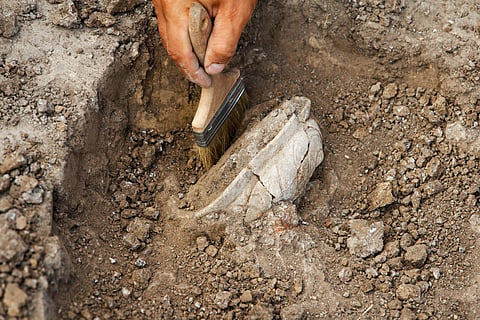
- Destinations
- Experiences
- Stay
- What's new
- Celebrating People
- Responsible Tourism
- CampaignsCampaigns
- SubscribeSubscribe
- Buy Now

Archaeological excavations are known to throw up extremely rare and interesting finds; but it is a bonus when such antiquities are unearthed during routine pipeline work. Recently, in Kerala, archaeologists were called in when a megalithic laterite burial chamber and relics were found at Nagaparamba in Kuttippuram village, near Tirunavaya, in district Malappuram.
The archaeological excavation that the Kerala State Archaeology Department conducted, led to a discovery of a substantial number of megalithic 'hat' stones. Often called Thoppikkallu in Malayalam, 'hat' stones were used as hemispherical laterite stones to serve as lids for burial urns in the megalithic era. This archaeological find is notable for its significance and potential scale, possibly representing one of the largest 'hat' stones gatherings in an unprotected state site.
Regrettably, many of these hat stones have faced inadvertent destruction by local residents, who were largely unaware of their archaeological relevance. The stones were harmed during land clearance for housing construction.
Archaeologist K Krishnaraj, the officer in charge of the Pazhassi Raja Archaeological Museum in Kozhikode, who led the salvage excavation, emphasised the importance of conducting a thorough survey and comprehensive documentation of the findings and the site itself.
The excavation at Nagaparamba yielded a substantial collection of megalithic hat stones and numerous burial sites and relics from that period. The discovery was initially triggered by unearthing a distinctive rock-cut laterite burial chamber during pipeline work. The salvage efforts led by Krishnaraj and his team brought to light a diverse array of earthen urns and distinctive iron implements, which hold the potential to provide insights into the lifestyles and cultures of the people inhabiting these lands over two millennia ago.
The uniqueness of the rock-cut cave's architectural features was a significant aspect, accompanied by the distinctive nature of the pots recovered from the chamber. These pots differed from the usual urns commonly found in similar sites. Remarkably, the urns retrieved from the burial chamber and beneath the hat stones contained ashes, presenting a distinct departure from the usual occurrence of cremated bones found in urns.
Local communities in Tirunavaya and its vicinity are excited about retrieving these hemispherical hat stones from Nagaparamba. Amidst their demand for the preservation of the archaeological site, there is a call for Tirunavaya to attain heritage status. Community members, recognising the historical significance of Tirunavaya, situated along the banks of the Bharathapuzha River, advocate for its official recognition as a heritage village.
